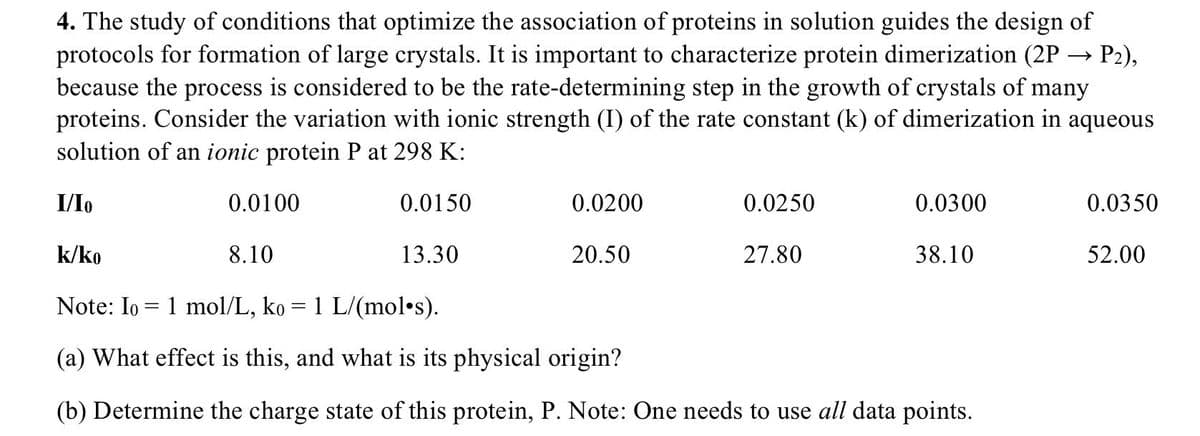4. The study of conditions that optimize the association of proteins in solution guides the design of protocols for formation of large crystals. It is important to characterize protein dimerization (2P - because the process is considered to be the rate-determining step in the growth of crystals of many proteins. Consider the variation with ionic strength (I) of the rate constant (k) of dimerization in aqueous solution of an ionic protein P at 298 K: P2), I/Io 0.0100 0.0150 0.0200 0.0250 0.0300 0.0350 k/ko 8.10 13.30 20.50 27.80 38.10 52.00 Note: Io = 1 mol/L, ko = 1 L/(mol•s). (a) What effect is this, and what is its physical origin? (b) Determine the charge state of this protein, P. Note: One needs to use all data points.
4. The study of conditions that optimize the association of proteins in solution guides the design of protocols for formation of large crystals. It is important to characterize protein dimerization (2P - because the process is considered to be the rate-determining step in the growth of crystals of many proteins. Consider the variation with ionic strength (I) of the rate constant (k) of dimerization in aqueous solution of an ionic protein P at 298 K: P2), I/Io 0.0100 0.0150 0.0200 0.0250 0.0300 0.0350 k/ko 8.10 13.30 20.50 27.80 38.10 52.00 Note: Io = 1 mol/L, ko = 1 L/(mol•s). (a) What effect is this, and what is its physical origin? (b) Determine the charge state of this protein, P. Note: One needs to use all data points.
Chemistry
10th Edition
ISBN:9781305957404
Author:Steven S. Zumdahl, Susan A. Zumdahl, Donald J. DeCoste
Publisher:Steven S. Zumdahl, Susan A. Zumdahl, Donald J. DeCoste
Chapter1: Chemical Foundations
Section: Chapter Questions
Problem 1RQ: Define and explain the differences between the following terms. a. law and theory b. theory and...
Related questions
Question

Transcribed Image Text:4. The study of conditions that optimize the association of proteins in solution guides the design of
protocols for formation of large crystals. It is important to characterize protein dimerization (2P –→ P2),
because the process is considered to be the rate-determining step in the growth of crystals of many
proteins. Consider the variation with ionic strength (I) of the rate constant (k) of dimerization in aqueous
solution of an ionic protein P at 298 K:
I/Io
0.0100
0.0150
0.0200
0.0250
0.0300
0.0350
k/ko
8.10
13.30
20.50
27.80
38.10
52.00
Note: Io = 1 mol/L, ko = 1 L/(mol•s).
(a) What effect is this, and what is its physical origin?
(b) Determine the charge state of this protein, P. Note: One needs to use all data points.
Expert Solution
This question has been solved!
Explore an expertly crafted, step-by-step solution for a thorough understanding of key concepts.
Step by step
Solved in 5 steps with 2 images

Knowledge Booster
Learn more about
Need a deep-dive on the concept behind this application? Look no further. Learn more about this topic, chemistry and related others by exploring similar questions and additional content below.Recommended textbooks for you

Chemistry
Chemistry
ISBN:
9781305957404
Author:
Steven S. Zumdahl, Susan A. Zumdahl, Donald J. DeCoste
Publisher:
Cengage Learning

Chemistry
Chemistry
ISBN:
9781259911156
Author:
Raymond Chang Dr., Jason Overby Professor
Publisher:
McGraw-Hill Education

Principles of Instrumental Analysis
Chemistry
ISBN:
9781305577213
Author:
Douglas A. Skoog, F. James Holler, Stanley R. Crouch
Publisher:
Cengage Learning

Chemistry
Chemistry
ISBN:
9781305957404
Author:
Steven S. Zumdahl, Susan A. Zumdahl, Donald J. DeCoste
Publisher:
Cengage Learning

Chemistry
Chemistry
ISBN:
9781259911156
Author:
Raymond Chang Dr., Jason Overby Professor
Publisher:
McGraw-Hill Education

Principles of Instrumental Analysis
Chemistry
ISBN:
9781305577213
Author:
Douglas A. Skoog, F. James Holler, Stanley R. Crouch
Publisher:
Cengage Learning

Organic Chemistry
Chemistry
ISBN:
9780078021558
Author:
Janice Gorzynski Smith Dr.
Publisher:
McGraw-Hill Education

Chemistry: Principles and Reactions
Chemistry
ISBN:
9781305079373
Author:
William L. Masterton, Cecile N. Hurley
Publisher:
Cengage Learning

Elementary Principles of Chemical Processes, Bind…
Chemistry
ISBN:
9781118431221
Author:
Richard M. Felder, Ronald W. Rousseau, Lisa G. Bullard
Publisher:
WILEY